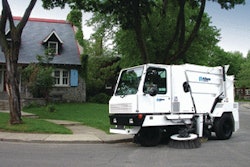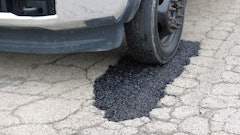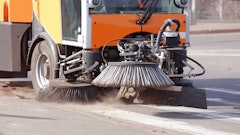Street and parking lot sweeping received another boost as an effective pollution-control effort following a one-year study conducted by Seattle Public Utilities (SPU).
"We had very high expectations and the 'big picture' message is street sweeping exceeded our expectations for pollution removal and cost effectiveness," says Terry Martin, acting division director for asset management of SPU.
Results of the 2006-2007 study were published in April, and among the recommendations was that Seattle "begin pursuing an expanded street sweeping program to reduce the amount of pollutants discharged to area-receiving water bodies from city streets... Data collected for this study clearly show that sweeping each side of the street every other week is very effective in reducing the amount of sediment and associated pollutants discharged from city streets."
Martin says the city does have plans for increased street sweeping but has been hampered by the tough economy which has resulted in fewer tax dollars flowing to the city.
"We're still planning what the future roll-out will look like, but once we get the money we plan on really expanding street sweeping," Martin says. "We will likely test some different ideas, such as frequency of sweeping, to see the impact, but the plan is to increase sweeping."
Stormwater management
Street sweeping has become a regular component of many cities' stormwater management programs. The study notes that sweeping streets is often specified in National Pollutant Discharge Elimination System (NPDES) permits. In California, for example, municipalities such as Sacramento County, San Jose, and Malibu are increasingly required to conduct street sweeping. Venice, FL, also requires street sweeping as part of its NPDES effort, and many utilities throughout the country "place great emphasis on the pollution prevention aspects of street sweeping as the primary best management practice (BMP) to control and improve water and air quality," according to the study.
Currently, the Seattle Department of Transportation (SDOT) performs all municipal street sweeping in the city, sweeping streets for road maintenance and aesthetic purposes rather than to maintain the drainage system, prevent flooding, or to improve water quality. The report notes that SDOT's street sweeping and leaf pickup operations have an annual budget of $1.2 million and a fleet of eight sweepers (four regenerative air and four mechanical sweepers).
Street sweeping is not required in Seattle's NPDES permit, but the city "recognizes that street sweeping may be an effective tool to reduce pollutant loading from city streets and could benefit both water and sediment quality in area receiving water bodies."
In addition, the city is responsible for managing the quality and quantity of stormwater discharged from the public storm drain system, which serves more than 40,000 acres in the Seattle metropolitan area. Under its NPDES permit, Seattle is required to annually inspect each of its more than 35,000 catch basins and to clean them when the sediment depth exceeds 60% of the sump depth, "or where the minimum clearance between the sediment surface and the invert of the lowest pipe is less than 6 in." Catch basin inspection and cleaning accounts for almost 60% of SPU's $3.7 million drainage-related maintenance budget.
"If street sweeping can reduce the frequency at which catch basins require cleaning, SPU could realize a significant savings in its maintenance budget for catch basin cleaning," the report notes. The hope was the study would answer these two questions:
- Does street sweeping reduce the rate of sediment accumulation in catch basins and thus reduce the frequency of catch basin cleaning?
- Does street sweeping increase the total amount of sediment and associated pollutants removed from a catchment compared to the amount removed by catch basin cleaning alone?
Additionally, because many pollutants present in urban runoff tend to sorb into or cling to particulates, particularly the smaller size particles (such as medium sand, silt, and clay), street sweeping might also be able to reduce the pollutants running into area water bodies.
"We looked at everything and asked ourselves, 'What if we really ramped up street sweeping?'" says Martin. "Is it cheaper than cleaning catch basins? Is it cheaper than building downstream treatment facilities? The study was designed to answer those questions."
Study results
Results of the study showed that sweeping each side of the street every other week "is very effective in reducing the amount of sediment and associated pollutants discharged from city streets." According to the study, sweeping reduced the amount of dirt in all three study areas. "The median monthly street dirt yield at the swept sites was 48, 74, and 90 percent less than the control (unswept) sites....On an annual basis, sweeping removed approximately 2,200 to 3,100 pounds of material per acre of street swept."
The study also found that sweeping can reduce the amount of pollutants discharged from streets to bodies of water. "Contaminants found in street dirt, sweeper waste, and catch basin samples included metals, petroleum hydrocarbons, and phthalates." Of these chemicals in the 55 samples analyzed, motor oil (82%), carcinogenic PAHs (78%), zinc (18%), chromium (15%) and a host of other chemical concentrations were above the Washington state sediment/soil standards and guidelines.
"Street sweeping has the potential to be an effective source control strategy by preventing a significant amount of sediment and associated contaminants from being discharged to receiving waters, which not only impacts water/sediment quality but also impairs substrate quality," the study determined.
Catch basin cleaning
The study expected that street sweeping would reduce the amount of sediment that accumulated in area catch basins, which SPU hoped would reduce the frequency at which catch basins needed to be cleaned and reduce the money spent on catch basin cleaning. Test results, however, did not show that street sweeping affected the amount or rate of sediment accumulation in the test area catch basins.
"Differences in the amount of sediment that accumulated in the catch basins between the swept and unswept sites at the end of the study period were not statistically significant, either on the basis of total mass or mass per unit area of street draining to the catch basin," according to the study.
So study results indicate that street sweeping might not help to reduce SPU's catch basin maintenance costs, which the study termed "a serious disappointment." On the other hand, the study found that most of the catch basins in the study sites were less than 10% full of sediment at the end of the study period - well below the 60% threshold at which catch basin cleaning would be required.
Cost-effective sweeping
Overall, the study determined that "street sweeping has the potential to be a cost-effective strategy for removing sediment and pollutants associated with sediment from roadways in the City of Seattle and is likely to be more cost-effective than annual catch basin cleaning or stormwater treatment."
Costs for a full-scale 2008 sweeping program were estimated at $43 per curb mile (based on SDOT's 2006 unit costs of $35 per curb mile, using a 3% inflation factor and a 15% contingency to convert to 2008 dollars). Solids handling and transportation costs were estimated at $34 per wet ton, and solids disposal was approximately $43.50 per wet ton.
Estimated life-cycle costs for a full-scale street sweeping program were $0.34 per wet kilogram of material removed and $0.62 per dry kilogram of material removed. In both wet and dry instances that's lower than the costs for the SPU city-wide catch basin cleaning program ($0.42 per wet kilogram and $0.74 per dry kilogram).
The study also determined that street sweeping is also cost effective compared to treating stormwater prior to discharge (which some communities opt for in lieu of upgrading street sweeping programs). The study estimated that street sweeping costs between 15% and 50% less than the cost of treating stormwater prior to discharge.
View a PDF of the sweeping study here at sweeping PDF.




![Pavement Awards 2025[main]](https://img.forconstructionpros.com/files/base/acbm/fcp/image/2024/05/PavementAwards_2025_main_.665883e4276e8.png?auto=format%2Ccompress&bg=fff&fill-color=fff&fit=fill&h=100&q=70&w=100)








![Pavement Awards 2025[main]](https://img.forconstructionpros.com/files/base/acbm/fcp/image/2024/05/PavementAwards_2025_main_.665883e4276e8.png?ar=16%3A9&auto=format%2Ccompress&bg=fff&fill-color=fff&fit=fill&h=135&q=70&w=240)







